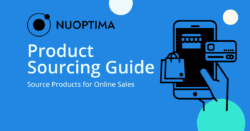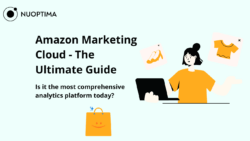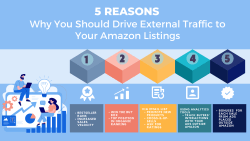Zusammenfassung
- Amazons Eigenmarken sind ein wachsendes Problem für Einzelhändler, die auf Amazon verkaufen wollen, und das zu Recht. Amazon hat in den letzten 10 Jahren Hunderte von Millionen in den Ausbau seiner Eigenmarken investiert, um Drittanbietern Marktanteile zu entreißen.
- Amazons aggressive Investitionen, gepaart mit dem Wachstum seines Eigenmarkengeschäfts, haben die Aufmerksamkeit von Regierungen und Medien auf sich gezogen, und Amazon sah sich mit einer Menge Kritik konfrontiert, wobei Markeninhaber Amazon beschuldigten, Daten Dritter zu verwenden, um seine eigenen Marken zu lancieren.
- Amazon betreibt über 100 Eigenmarken, die in fast allen wichtigen Nischen verkauft werden, darunter Lebensmittel und Getränke, Automobile, Kleidung und Elektronik. Amazon will das tun, was der stationäre Handel seit 70 Jahren tut. Während dies eine gute Nachricht für die Kunden ist, die ein gutes Produkt zu einem niedrigeren Preis erhalten, ist es nicht so gut für kleine FBA-Marken, die ihren Marktanteil an Amazon verlieren.
Einführung
Das Szenario ist uns allen bekannt: Sie finden ein Markenprodukt in einem Gang Ihres Lieblingsgeschäfts, aber nachdem Sie sich umgesehen haben, finden Sie ein identisches Produkt zu einem viel niedrigeren Preis. Dieses billigere Produkt sieht zwar mit seinem typischen, einfachen Branding und seiner Verpackung weniger beeindruckend aus, aber für die meisten von uns steht das Branding nicht ganz oben auf unserer Prioritätenliste, wenn wir nach Waren des täglichen Bedarfs suchen. Die Funktion und der Preis sind das Wichtigste. In diesem Sinne entscheiden sich die meisten von uns für die günstigere Variante.
Einzelhändler stellen seit Mitte des 19. Jahrhunderts Eigenmarkenprodukte her, aber für Online-Händler wie Amazon ist dies ein neuer Geschäftszweig. Dies und die Kaufkraft von Amazon machen es für kleine Fulfillment by Amazon (FBA)-Verkäufer extrem schwierig, mit Amazons Eigenmarkenprodukten zu konkurrieren.
Dieser Artikel gibt Ihnen einen Einblick, wie Sie mit Amazon konkurrieren können, auch wenn Ihre FBA-Marke in einer Nische liegt, in der die Eigenmarken von Amazon tätig sind.
Was ist eine Händlermarke?
Private Label ist ein Geschäftsmodell, bei dem ein Hersteller einen Artikel produziert, der nur von einem bestimmten Einzelhändler unter dessen Marke verkauft wird. Der Einzelhändler verwendet sein Branding, einschließlich Logo, Etiketten und Verpackungsbeilagen, und nicht der Hersteller.
Dieses Modell gibt es schon seit Jahrzehnten - denken Sie an Aldi in Europa, Walmart in den Vereinigten Staaten oder Tescos im Vereinigten Königreich. Wenn Sie das nächste Mal bei Tesco oder Walmart einkaufen, schauen Sie, ob Sie eine Eigenmarke entdecken. Vielleicht sehen Sie zum Beispiel eine bekannte Windelmarke wie Pampers, die wahrscheinlich viel teurer ist als die Eigenmarke des Einzelhändlers.
Das Eigenmarkenmodell erfordert einen gewissen zusätzlichen Aufwand seitens des Einzelhändlers, der in der Regel für die Entwicklung, Herstellung, Vermarktung und den Markenschutz der Eigenmarkenprodukte verantwortlich ist.
Wie jeder andere Einzelhändler nutzt auch Amazon die Daten seiner Drittanbieter, um Produkte schneller und zu einem niedrigeren Preis auf den Markt zu bringen als diese. Amazon kann seine Größenvorteile nutzen, um niedrigere Preise von den Herstellern zu erhalten und die Produkte auf seiner Plattform mit Hilfe der erstklassigen Expertise seiner eigenen Mitarbeiter zu vermarkten.
Wie hat Amazon seine Eigenmarken gestartet?
2009 führte Amazon seine ersten Eigenmarken ein - AmazonBasics und Pinzon. Beide Marken waren auf Haushaltsartikel spezialisiert. Seit 2009 hat Amazon sein Portfolio an Eigenmarken von nur 30 Marken im Jahr 2017 auf mittlerweile über 100 Marken erweitert.
Einige der Marken von Amazon, wie Echo oder Kindle, sind besonders beliebt. Die meisten sind jedoch der breiten Öffentlichkeit nicht bekannt. Während Amazon einige seiner Marken unter der Rubrik "Unsere Marken" aufgeführt hat, sind die übrigen entweder im Titel oder irgendwo in der Auflistung als "Amazon-Marke" gekennzeichnet. In den letzten Jahren hat Amazon seinen Markenbesitz diversifiziert und über 100 Amazon-Exklusivmarken in Partnerschaft mit etablierten oder aufstrebenden Marken eingeführt.
Diese beiden Amazon-Markentypen haben ganz unterschiedliche Geschäftsstrategien, fallen aber beide unter das Dach "Unsere Marken".
Amazon gibt nicht öffentlich an, welche der Marken auf seiner Website Eigenmarken und welche Amazon-Exklusivmarken sind, aber es listet die Logos einiger der bekanntesten Amazon-Marken auf. Hier sind ein paar von ihnen:
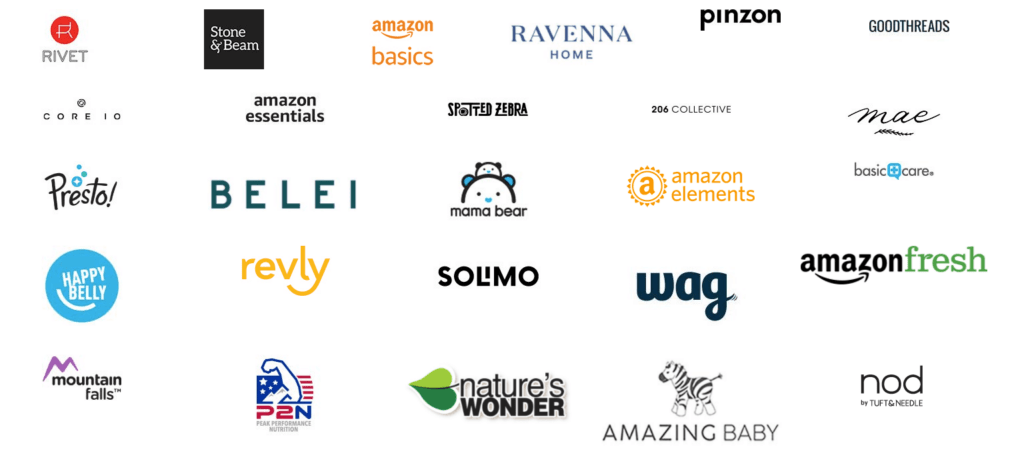
Obwohl Amazon versucht hat, in anderen Nischen zu verkaufen, wie z. B. technisches Zubehör, scheint das Unternehmen einen breiteren Markt mit Alltagsgütern anzusteuern, die den täglichen Bedarf des Durchschnittsbürgers decken - ein Markt, in dem Amazon bereits erfolgreich ist.
Wie viele Eigenmarken hat Amazon?
Amazon war in den letzten 10 Jahren sehr damit beschäftigt, seine eigene Markenpalette aufzubauen. Mit 158.000 Produkten in 45 Marken bis 2019 wächst Amazon jeden Tag weiter, schafft mehr Eigenmarken und wird zu einem Wettbewerber, den Amazon-Verkäufer im Auge behalten müssen. Bis heute hat der Online-Riese rund 400 Eigenmarken und Exklusivmarken eingeführt.
Die Eigenmarken von Amazon konzentrierten sich zunächst auf drei Kategorien: Bekleidung, Haushaltswaren und Lebensmittel. Inzwischen expandiert der E-Commerce-Riese jedoch in viele andere Kategorien.
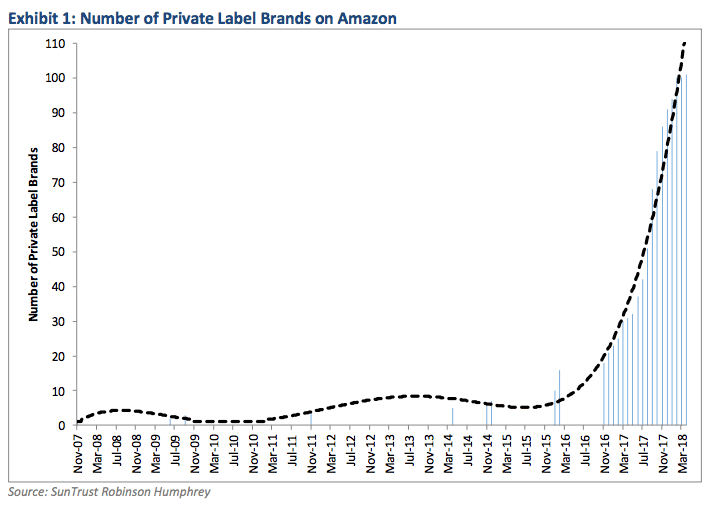
Nach Angaben des Forschungsunternehmens GartnerL2 haben die meisten der 100 Eigenmarken, die Amazon besitzt, keine guten Ergebnisse erzielt und machen zusammen weniger als 1% des Umsatzes aus. Die erfolgreichsten Amazon-Eigenmarken sind AmazonBasics, Amazon Collection und Amazon Essentials. Amazon scheint Eigenmarkenartikel zu bevorzugen, die qualitativ hochwertige, generische Artikel zu einem niedrigeren Preis als anderswo im Internet anbieten.
Wie können Sie mit Amazon Private Label Marken konkurrieren?
Der Verkauf in einer Kategorie, die bereits von Amazon dominiert wird, ist ein harter Kampf. Amazon hat einige offensichtliche Vorteile, wie z. B. eine größere Kaufkraft, höhere Marketingbudgets und eine riesige Menge an Kundendaten, die es zu nutzen gilt. Für kleinere E-Commerce- oder FBA-Marken scheint es einfach nicht machbar zu sein, mit Amazon um Marktanteile zu konkurrieren.
Dennoch gibt es ein paar Dinge, die Sie tun können, um die Erfolgschancen Ihrer Marke zu erhöhen, wenn Sie sich mit dem König des E-Commerce messen:
Wenn Sie nicht bereits auf Amazon verkaufen
Wenn Sie noch nicht auf Amazon verkaufen und eine Marke auf der Plattform einführen möchten, empfehlen wir Ihnen dringend, sich von Nischen fernzuhalten, in denen Amazon einen starken Marktanteil hat, wie z. B. Elektronik, Lebensmittel, Kleidung und Elektronikzubehör. Abgesehen von der Tatsache, dass Sie es schwer haben werden, sich einen Vorteil gegenüber Amazon zu verschaffen, sind diese Kategorien aufgrund ihrer natürlichen Konkurrenzsituation ohnehin nicht die besten Nischen für die Einführung von Marken auf Amazon.
Einige der besten Nischen, um eine Amazon FBA-Marke zu gründen, sind alltägliche Waren wie Töpfe und Pflanzenzubehör, Schilder und Nischenbeleuchtung sowie individuell gestaltbare Tapeten. Diese Bereiche sind sehr nischig und werden nicht von Amazon oder einer bekannten Marke dominiert. Grundsätzlich gilt: Je weniger "cool" die Nische ist, desto besser.
Wenn Sie bereits auf Amazon verkaufen
Branding und Markengeschichte
Amazons Eigenmarken sind nur auf eines ausgerichtet: ein Produkt zum niedrigstmöglichen Preis zu verkaufen. Allerdings mangelt es ihren Marken in der Regel an Markenbildung oder Qualität. Hier sind Sie im Vorteil.
Sie haben also hart daran gearbeitet, Ihre Marke auf den Weg zu bringen. Sie haben ein Qualitätsprodukt geschaffen. Sie haben sich die Zeit genommen, ein Team aufzubauen und sicherzustellen, dass Sie einen Mehrwert liefern. Wir wissen das, weil wir beruflich mit Markeninhabern sowohl auf als auch außerhalb von Amazon sprechen. Als Markeninhaber müssen Sie sicherstellen, dass Ihre Markengeschichte auf Amazon während Ihrer gesamten Markenreise kommuniziert wird. Dies ist eine der besten Möglichkeiten, um sich von Amazon abzuheben.
Die meisten E-Commerce-Marken außerhalb von Amazon leisten zwar gute Arbeit, aber aus dem einen oder anderen Grund gelingt es ihnen nicht, ihre Markengeschichte und Vision auf Amazon zu vermitteln, und sie verlieren gegen Amazon. Die besten einheimischen Amazon FBA-Marken leisten erstaunliche Arbeit, wenn es darum geht, ihre Markengeschichte zu erzählen, was ihnen hilft zu wachsen, obwohl sie direkt mit Amazon konkurrieren.
Hier sind einige der besten Möglichkeiten, um Ihre Markengeschichte zu erzählen und die Verbraucher davon zu überzeugen, Ihr Produkt auf Amazon zu kaufen:
- Verwenden Sie Ihre Beschreibung, um die Vorteile Ihres Produkts zu verkaufen, und listen Sie nicht nur die Merkmale auf.
- Laden Sie 6-8 hochwertige Bilder hoch, darunter 2-3 emotional ansprechende Lifestyle-Bilder und mindestens 1 hochwertiges Video, das auf Social Proof basiert.
- Achten Sie darauf, dass Ihre Bilder auffällig sind, damit sie in den Suchergebnissen und Anzeigen auffallen.
- Vergewissern Sie sich, dass Sie den Kunden mit großartigem Bildmaterial und ansprechenden Verkaufstexten auf eine Reise vom Anfang bis zum Ende Ihres Angebots mitnehmen.
- Erstellen Sie eine sehr visuelle und vorteilhafte Shop-Seite, um die Besucherzahlen zu erhöhen.
Marketing
Stellen Sie sicher, dass Sie die Merkmale hervorheben, die Ihr Produkt im Vergleich zu billigeren Amazon-Eigenmarkenprodukten einzigartig machen. Hier können Sie all Ihre Marktforschungs- und Kundenavatar-Daten nutzen, um Ihr Publikum anzusprechen.
Heben Sie in Ihren Angeboten und Ihrem Marketing auf Amazon immer alles hervor, was an Ihrem Produkt einzigartig ist. Hier sind einige der besten Alleinstellungsmerkmale, die Sie bei Ihren Marketingbemühungen auf Amazon hervorheben sollten:
- Sozialer Beweis
Erwähnen Sie Ihre Anhängerschaft in den sozialen Medien, wenn Sie eine große Fangemeinde aufgebaut haben.
- Geistiges Eigentum (IP)
Heben Sie Patente oder Markenzeichen immer hervor, damit Sie sich von der Masse abheben und das Vertrauen der Kunden und die Konversionsrate erhöhen.
- Kundenergebnisse
Für potenzielle Käufer ist es immer nützlich, die Ergebnisse zu sehen, die Ihre Kunden erzielt haben. Je mehr Sie haben, desto besser. Am besten ist es, wenn Sie diese im Videoformat zur Verfügung stellen und sie in Ihren A+-Inhalten hervorheben.
- Hochwertige Materialien
Weisen Sie auf etwaige Qualitätsunterschiede hin, die Ihr Produkt zur besseren Wahl machen könnten. Zum Beispiel, wenn Ihre Produkte aus echtem Leder hergestellt sind, während Amazon Kunstleder oder ein minderwertiges Leder verkauft.
- Ethische Beschaffung oder ethische Herstellung
Die Kunden sind immer bereit, für Produkte aus ethischen Quellen mehr zu bezahlen.
Kundenbetreuung
Außergewöhnlicher Kundenservice ist ein Wettbewerbsvorteil für jede E-Commerce-Marke, die auf einer beliebigen Plattform verkauft, und Amazon ist da keine Ausnahme. Als kleine oder mittelgroße FBA-Marke müssen Sie die Erwartungen Ihrer Kunden weit übertreffen, um eine hohe Kundenbindungsrate zu gewährleisten, von Mund-zu-Mund-Propaganda (WOM) zu profitieren und - was noch wichtiger ist - gute Bewertungen zu erhalten.
Auf einer rezensionsbasierten Plattform wie Amazon sind Rezensionen das Lebenselixier Ihrer Marke, und ein hervorragender Kundenservice ist eine der besten Möglichkeiten, um jeden Tag einen Zustrom positiver Rezensionen zu gewährleisten. Über sich hinauszuwachsen und einen großartigen Kundenservice zu bieten, ist keine Raketenwissenschaft. Sorgen Sie immer dafür, dass Ihre Kunden zufrieden sind und sich als Teil einer Gemeinschaft fühlen.
Hier sind einige unserer besten Tipps für einen guten Kundenservice auf Amazon:
- Beantwortung von Fragen in Produktangeboten.
- Stellen Sie sicher, dass Sie so viele Kundenfragen wie möglich durch Ihre Inserate vorwegnehmen.
- Nachfass-E-Mails versenden - bedanken Sie sich bei Ihren Kunden und bitten Sie um ehrliches Feedback.
- Packungsbeilagen - einfacher Text auf den Beilagen, um Dankbarkeit auszudrücken.
Eine Gemeinschaft aufbauen
Dies ist bei weitem der wichtigste Schritt, den Sie unternehmen können, um das Vertrauen Ihrer Kunden zu stärken. Unabhängig davon, ob Sie auf Amazon verkaufen oder nicht, sorgt der Aufbau einer Community, in der Sie Ihre Kunden versammeln, um mit Ihnen und Ihrer Marke zu interagieren, für einen Teil des Ökosystems Ihrer Marke, über den Sie die Kontrolle haben.
Ein gutes Beispiel für eine große Gemeinschaft ist die Marke BrüMate. BrüMate hat in den letzten Jahren die Welt des Alkoholzubehörs erobert, indem es ein großartiges Produkt verkauft, brillantes Marketing betreibt und eine unglaublich loyale und aktive Gemeinschaft aufgebaut hat, vor allem über eine Facebook-Gruppe.
Der Aufbau einer starken Gemeinschaft treuer Fans sorgt dafür, dass sich Ihre Marke von Amazon-Eigenmarken und bekannten Marken außerhalb von Amazon abhebt.

Produktvariation
Bündelung ist eine einfache, aber wirkungsvolle Methode, um sich von der Konkurrenz auf Amazon abzuheben. Sie können entweder ein Produkt mit Ihrem Kernangebot bündeln oder einfach ein zusätzliches Stück zum Kernangebot hinzufügen, wie z. B. eine bessere Geschenkverpackung, ein Band oder eine Bambustragetasche.
Alles, was Sie zu Ihrem Heldenprodukt hinzufügen können, hebt Sie von Amazon ab.
Neben der Bündelung und dem Angebot eines anderen Produkts sollten Sie versuchen, eine Variante zu verkaufen, die Ihre Konkurrenten nicht anbieten.
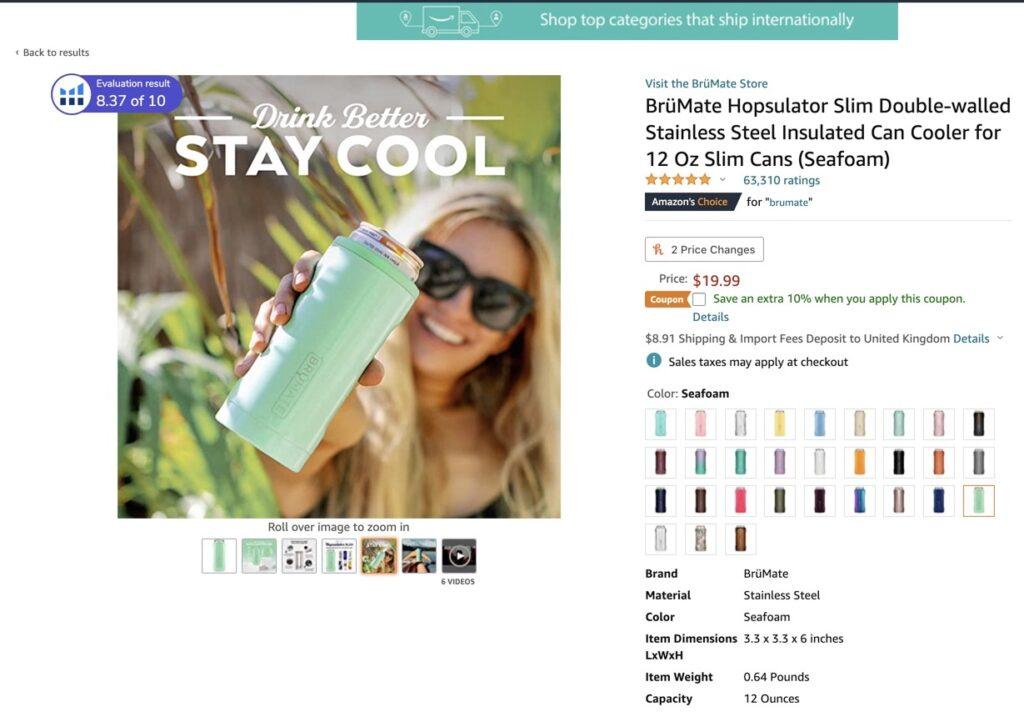
Abschließende Überlegungen
Die Eigenmarken von Amazon sind auf Dauer angelegt und werden wahrscheinlich weiter wachsen. Als kleine E-Commerce-Marke wissen Sie, dass Sie auf Amazon verkaufen müssen, um Zugang zu Hunderten von Millionen aktiver Käufer auf der Plattform zu erhalten, oder Sie riskieren, Marktanteile an Ihre Wettbewerber zu verlieren. Unabhängig davon, ob Sie bereits auf Amazon verkaufen oder eine Amazon FBA-Marke gründen wollen, müssen Sie Ihre Marke von den Amazon-Marken abheben, indem Sie die Alleinstellungsmerkmale (USPs) Ihrer Produkte durch Branding, Storytelling und den Aufbau einer aktiven Gemeinschaft von begeisterten Käufern vermarkten.
